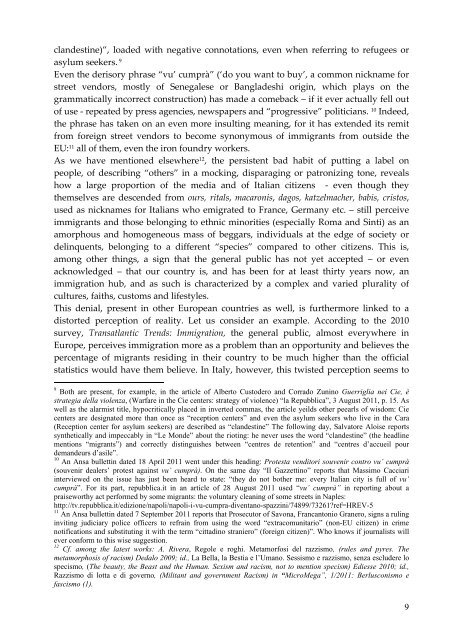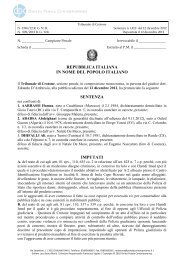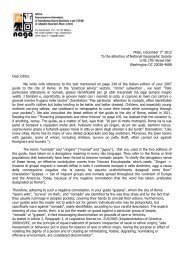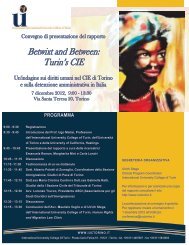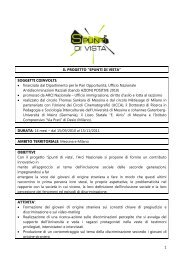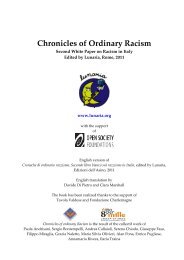Chronicles of ordinary racism 2011 - Cronache di ordinario razzismo
Chronicles of ordinary racism 2011 - Cronache di ordinario razzismo
Chronicles of ordinary racism 2011 - Cronache di ordinario razzismo
- No tags were found...
You also want an ePaper? Increase the reach of your titles
YUMPU automatically turns print PDFs into web optimized ePapers that Google loves.
clandestine)”, loaded with negative connotations, even when referring to refugees or<br />
asylum seekers. 9<br />
Even the derisory phrase “vu’ cumprà” (‘do you want to buy’, a common nickname for<br />
street vendors, mostly <strong>of</strong> Senegalese or Bangladeshi origin, which plays on the<br />
grammatically incorrect construction) has made a comeback – if it ever actually fell out<br />
<strong>of</strong> use ‐ repeated by press agencies, newspapers and “progressive” politicians. 10 Indeed,<br />
the phrase has taken on an even more insulting meaning, for it has extended its remit<br />
from foreign street vendors to become synonymous <strong>of</strong> immigrants from outside the<br />
EU: 11 all <strong>of</strong> them, even the iron foundry workers.<br />
As we have mentioned elsewhere 12 , the persistent bad habit <strong>of</strong> putting a label on<br />
people, <strong>of</strong> describing “others” in a mocking, <strong>di</strong>sparaging or patronizing tone, reveals<br />
how a large proportion <strong>of</strong> the me<strong>di</strong>a and <strong>of</strong> Italian citizens ‐ even though they<br />
themselves are descended from ours, ritals, macaronis, dagos, katzelmacher, babis, cristos,<br />
used as nicknames for Italians who emigrated to France, Germany etc. – still perceive<br />
immigrants and those belonging to ethnic minorities (especially Roma and Sinti) as an<br />
amorphous and homogeneous mass <strong>of</strong> beggars, in<strong>di</strong>viduals at the edge <strong>of</strong> society or<br />
delinquents, belonging to a <strong>di</strong>fferent “species” compared to other citizens. This is,<br />
among other things, a sign that the general public has not yet accepted – or even<br />
acknowledged – that our country is, and has been for at least thirty years now, an<br />
immigration hub, and as such is characterized by a complex and varied plurality <strong>of</strong><br />
cultures, faiths, customs and lifestyles.<br />
This denial, present in other European countries as well, is furthermore linked to a<br />
<strong>di</strong>storted perception <strong>of</strong> reality. Let us consider an example. Accor<strong>di</strong>ng to the 2010<br />
survey, Transatlantic Trends: Immigration, the general public, almost everywhere in<br />
Europe, perceives immigration more as a problem than an opportunity and believes the<br />
percentage <strong>of</strong> migrants resi<strong>di</strong>ng in their country to be much higher than the <strong>of</strong>ficial<br />
statistics would have them believe. In Italy, however, this twisted perception seems to<br />
9 Both are present, for example, in the article <strong>of</strong> Alberto Custodero and Corrado Zunino Guerriglia nei Cie, è<br />
strategia della violenza, (Warfare in the Cie centers: strategy <strong>of</strong> violence) “la Repubblica”, 3 August <strong>2011</strong>, p. 15. As<br />
well as the alarmist title, hypocritically placed in inverted commas, the article yeilds other peearls <strong>of</strong> wisdom: Cie<br />
centers are designated more than once as “reception centers” and even the asylum seekers who live in the Cara<br />
(Reception center for asylum seekers) are described as “clandestine” The following day, Salvatore Aloise reports<br />
synthetically and impeccably in “Le Monde” about the rioting: he never uses the word “clandestine” (the headline<br />
mentions “migrants”) and correctly <strong>di</strong>stinguishes between “centres de retention” and “centres d’accueil pour<br />
demandeurs d’asile”.<br />
10 An Ansa bullettin dated 18 April <strong>2011</strong> went under this hea<strong>di</strong>ng: Protesta ven<strong>di</strong>tori souvenir contro vu’ cumprà<br />
(souvenir dealers’ protest against vu’ cumprà). On the same day “Il Gazzettino” reports that Massimo Cacciari<br />
interviewed on the issue has just been heard to state: “they do not bother me: every Italian city is full <strong>of</strong> vu’<br />
cumprà”. For its part, repubblica.it in an article <strong>of</strong> 28 August <strong>2011</strong> used “vu’ cumprà” in reporting about a<br />
praiseworthy act performed by some migrants: the voluntary cleaning <strong>of</strong> some streets in Naples:<br />
http://tv.repubblica.it/e<strong>di</strong>zione/napoli/napoli-i-vu-cumpra-<strong>di</strong>ventano-spazzini/74899/73261ref=HREV-5<br />
11 An Ansa bullettin dated 7 September <strong>2011</strong> reports that Prosecutor <strong>of</strong> Savona, Francantonio Granero, signs a ruling<br />
inviting ju<strong>di</strong>ciary police <strong>of</strong>ficers to refrain from using the word “extracomunitario” (non-EU citizen) in crime<br />
notifications and substituting it with the term “citta<strong>di</strong>no straniero” (foreign citizen)”. Who knows if journalists will<br />
ever conform to this wise suggestion.<br />
12 Cf. among the latest works: A. Rivera, Regole e roghi. Metamorfosi del <strong>razzismo</strong>, (rules and pyres. The<br />
metamorphosis <strong>of</strong> <strong>racism</strong>) Dedalo 2009; id., La Bella, la Bestia e l’Umano. Sessismo e <strong>razzismo</strong>, senza escludere lo<br />
specismo, (The beauty, the Beast and the Human. Sexism and <strong>racism</strong>, not to mention specism) E<strong>di</strong>esse 2010; id.,<br />
Razzismo <strong>di</strong> lotta e <strong>di</strong> governo, (Militant and government Racism) in “MicroMega”, 1/<strong>2011</strong>: Berlusconismo e<br />
fascismo (1).<br />
9


